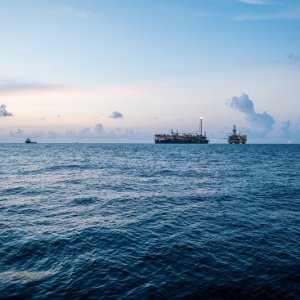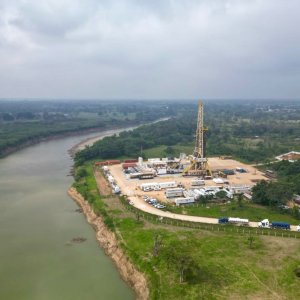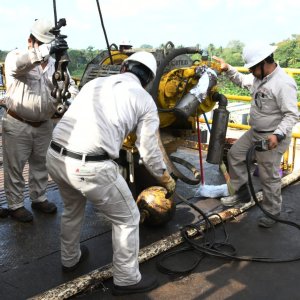Litoral de Tabasco Fields Gain Prominence
STORY INLINE POST
Discovered in 1989, Litoral de Tabasco is a shallow water complex located in the southwestern area of the Campeche Basin, which is the country’s most important petroleum province. It consists of a set of 11 fields of light oil and condensate that range from 30°API to 51°API. The Litoral de Tabasco complex is part of the Pemex E&P’s Southwest Marine Region and covers an area of more than 11,000km2. Maximum water depth in this area is 35m, with the main reservoirs being Kimmeridgian dolomitized oolitic banks and Cretaceous fractured carbonates deposited in an open platform. The Litoral de Tabasco project has been developed with 44 wells and 24 platforms using shared facilities, while the main production facility – the CA Litoral-A Compression gas facility – is located at a water depth of 26m.
Originally yielding around 6,000 b/d of oil and 6 mcf/d of gas, Litoral de Tabasco’s production was increased significantly with the addition of the project Och-Uech-Kax in 1996, hitting a peak of 94,000 b/d of oil and 200 mcf/d of gas. Subsequently, three new projects were added by 2002 – Crudo Ligero Marino, Yaxche and Ayin-Alux – further boosting production to record levels around 120,000 b/d of oil and 265 mcf/d of gas. The discoveries of May, Bolontiku, Tsimin, Xux, Kab, and Yum increased the importance of Litoral de Tabasco to being the third ranked asset in both oil and gas production with averages of 319,219 b/d of oil and 735.77 mcf/d of gas in 2012, according to CNH figures.
According to Luis Vielma Lobo, Director General of CBM, Litoral de Tabasco is one of the most interesting areas that Pemex is developing right now because of the easy oil conditions it still presents. “The Litoral de Tabasco area is perhaps the most important opportunity for Pemex, due to the very low water content, wells that can reach production levels of 10,000 b/d, and a low average ratio of oil to gas production,” he explains.
Given these production conditions, Litoral de Tabasco has become one of the most lucrative areas for Pemex to invest. “The place where we get the best return on investment is Litoral de Tabasco,” explains Carlos Morales Gil, Director General of Pemex E&P. “It is one of the most profitable areas for the company, since it involves very cheap oil at wells with high pressure, and very high temperature, where even at the deepest reservoirs production costs are under US$5 per barrel.”
CRUDO LIGERO MARINO
Pemex E&P started production of the Crudo Ligero Marino Project in 2003, with the Sinan field, which is located o the coast of Tabasco and Campeche. The May, Bolontiku, Tsimin, Xux, Kab, and Yum fields were subsequently put into production and last year collectively produced an average of 163,058 b/d, which add up to 51% of total crude production in the Litoral de Tabasco asset. Gas production in the field averaged 610.2 mcf/d, which is 83% of the asset’s total production for this hydrocarbon. With the recent start of exploitation activities in Tsimin-Xux, Pemex expects to yield around 300,000 b/d of oil from the whole complex by 2016. The operational strategy consists of drilling 63 exploratory wells, 73 geological studies, and the acquisition of 2,318km2 of seismic information, a plan that the company hopes will maximize production in the shortest possible timespan.
YAXCHÉ
The Yaxché field is located o the coast of Tabasco, approximately 13km northwest of the port of Dos Bocas. It was originally discovered in 2008 and reached an average production of 56,012 b/d of oil and 27.2 mcf/d of gas in 2012, according to CNH figures. Averaging a 33°API density, Yaxché’s oil assets amount for 66 million bbl 1P reserves, 149 million bbl 2P reserves, and 258 million bbl 3P reserves. The field also contains 43 bcf 1P reserves, 98 bcf 2P reserves, and 171 bcf 3P reserves of gas. The strategy for Yaxché’s production stages includes the exploitation of 203 million bbl of oil and 120 bcf of gas by 2034. This is planned to be performed by drilling 20 wells and finishing 21 additional development wells; performing 159 well interventions, of which three would be major repairs, 105 would be minor repairs and the rest would consist of stimulations and 35 well blockages.























